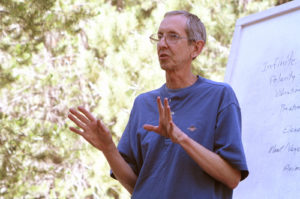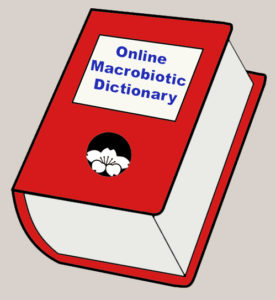
Completed Entries
General name for many kinds of Japanese stew. Nabe means pot.
Cultivated jinenjo.
Chinese cabbage or hakusai (Japanese name).
Fermented soybean product that has an unusual taste, faintly resembling Roquefort cheese, and is typically prepared with special enzyme.
Foods that don’t contain additives or preservatives and that have undergone minimal (if any) processing.
Natural immunity (resistance to sickness without prior immunization) is a characteristic of health—the normal condition of all living beings. This immunity depends on the quality of red and white blood cells considered by macrobiotics as primarily created by one’s nutrition and activity. Thus, healthy blood leads to immunity from infectious diseases.
“My therapy is very simple: Natural food, no medicine, no surgery, no inactivity…avoid animal protein as much as possible, and completely avoid refined sugar.” (Zen Macrobiotics 26-27)
The visible world of which the human body is a small part and to which it owes its existence.
See Order of the Universe.
Life before polarization which then manifests itself through yin-yang activities. “By nature, we possess a cloudless wisdom, given that we are born of that infinite, absolute world, which is of God. We are all children of God….Forgetting this truth is the cloud that causes us to be sick.” Order of the Universe,30.
Bitter liquid (bitterns) that drips from damp sea salt, traditionally used to solidify tofu.
Style of cooking in which vegetables are cut in fairly large pieces, boiled slowly over low heat for a long time, and seasoned with soy sauce.
Style of cooking in which vegetables are cut in fairly small and boiled for a short time.
Ohsawa encourages people not to complain because he believed it shows a lack of a joyful attitude and gratitude. Rather than complaining, he urged people to work to change something objectionable into something that can be tolerated using macrobiotic principles.
Ohsawa teaches that in there are no enemies in the relative world. “Our philosophy also teaches that no enemy or evildoer exists in this world—nature and human society included. There is only misunderstanding, incomprehension, or awkward behavior.” Cancer and the Philosophy of the Far East, 100. However, humans view some people (and things such as cancer) as enemies. In these cases, Ohsawa encourages people to change enemies to friends using macrobiotic principles. He says cancer, for example, can be seen as beneficial because it shows that changes in one’s life are needed to remedy it.
Ohsawa wrote in a categorical way and often overstated the case in order to get people to move in what he considered a better direction. For example he wrote, “Even when you are resented, envied, or scolded by mistake or misunderstanding, you should not make any excuses because there is no excuse in nature. Only man makes excuses.” Macrobiotic Guidebook for Living, 115. As Herman Aihara put it, “Nature doesn’t accept excuses, but our parents and others do; so, we learn to make them.” Kaleidoscope, 282. Herman believed that making excuses was a function of one’s small ego and that if one could let go of the desires of the small ego, he or she could gain higher consciousness and a greater understanding of his or her true self.
Literally, “credo” means “I believe.” Ohsawa used “non credo” to mean “do not believe without verifying for yourself.” This motto became one of his favorites and he encouraged people to apply it to all teachings and theories, including his own. When evaluating whether or not to believe or do something, try it and see for yourself and learn from your failures and mistakes.
“Every antagonism is complementary.” This principle negates formal logic. All things are constantly in motion and thus changing due to the interplay of opposites. This law is another way of saying that everything changes and to look for both sides of every situation. This is the fifth of Seven Laws of the Order of the Universe.
See Logic, Aristotelian.
Macrobiotics is a nondual philosophy that literally means “not two.” It is opposed to dualism—the view that two substances (matter and spirit for example) are completely separate from each other. This idea negates monism—the theory that there is only one entity or principle that is the basis of reality. This Oneness produces all things through the interactions of connected yet opposing forces or tendencies.
There are well over 300 types of noodles and pastas from around the world. Macrobiotics recommends eating whole grains as one’s primary food, with noodles as secondary and less often. When used, the macrobiotic recommendation is to choose noodles and pastas made from naturally-grown whole grains (as available) without chemicals, preservatives, or added sugar. The most used noodles in macrobiotic practice include soba (buckwheat or buckwheat combined with wheat flour), udon (whole wheat, thick), somen (whole wheat, thin, usually served cold), ramen (whole wheat, quick cooking), rice, corn, quinoa, saifun (bean threads), and harusame (bean, rice, sweet potato, or other starch). Pastas like whole wheat spaghetti or macaroni made from durum wheat are used on occasion as well. While whole grains are slightly-to-moderately yang, noodles and pastas are considered to be slightly yin.
Versatile seaweed of red algae family that is delicate, leafy, and brownish in color. It is cultivated in Japan and available in thin sheets after natural processing. It is useful in helping with the digestion of fats and is very high in vitamins (especially vitamin A) and minerals.
Rice bran, roasted and mixed with salt for pickling vegetables.
One of George Ohsawa’s dietary plans in which one eats one hundred percent whole grains along with a minor amount of specific condiments for a brief period of time (three to ten days) in order to cleanse the body of excess toxins. This temporary healing diet also includes the instruction to drink as few beverages (other than water) as possible. Note: Current practice is not to restrict water in any way; each person should make certain to drink an adequate amount of water each day at all times. Note also that Diet Number Seven is not intended for long-term use.
Nuts are a good source of fat, fiber, and protein, and contain ample amounts of vitamins and minerals. They are used as supplemental or pleasure foods in macrobiotic practice and are considered from yin (almonds, chestnuts, pine nuts, and walnuts) to strong yin (macadamia nuts, pistachios, filberts, hazelnuts, peanuts, and pecans) to extreme yin (Brazil nuts and cashews). Most nuts are mildly acid forming, especially the more yin ones. They are eaten as snacks and are often used in desserts, sauces, and dressings. As with all foods, the macrobiotic recommendation is to avoid nuts that are artificially produced with chemical fertilizers and/or insecticides.
Projected Entries
Nakamura, Abe
Nakayama, Tommy
Nakazono, Ben
Nasal bleeding
Nasal discharge
Natto miso
Natural agriculture
Natural death
Natural medicine
Natural order
Natural origin
Natural sweeteners
Nephritis
Nei Ching
Nervous system (parasympathetic, sympathetic, vegetative)
Neurasthenia
New edition
Niacin
Nicotine
Nippon C. I.
Nitrogen
Non-fertilized eggs
Questions or Comments?




